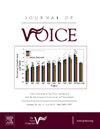基于卷积神经网络分类器的集合学习,利用喉部图像和声音诊断早期声门癌
IF 2.5
4区 医学
Q1 AUDIOLOGY & SPEECH-LANGUAGE PATHOLOGY
引用次数: 0
摘要
研究目的决策树集合学习是提高相对较小数据集分类准确性的方法之一,本研究的目的是通过比较决策树集合学习与卷积神经网络(CNN)算法在喉癌诊断中的应用结果来提高分类准确性:方法:使用釜山大学医院(PNUH)数据集建立分类器,并使用釜山大学梁山医院(PNUYH)数据集验证生成模型中分类器的性能。对于声门癌的诊断,利用喉部图像和语音数据建立了基于深度学习的 CNN 模型并进行了分类。通过 CNN 分类算法,利用概率进行决策树集合学习,从而获得了分类的准确性。在此过程中,使用了分类和回归树(CART)方法。然后,我们通过将喉部图像与语音决策树分类器融合,比较了决策树集合学习与 CNN 单个分类器的分类准确率:结果:使用 PNUH 训练数据集建立的喉部图像和语音分类模型的分类准确率分别为 81.03 % 和 99.18 %。然而,在使用 PNUYH 外部数据集时,CNN 分类器的语音分类准确率下降到 73.88%,喉部图像分类准确率下降到 68.92%。为了解决这个问题,我们采用了喉图像和声音的决策树集合学习,并通过整合同一人的喉图像和声音数据提高了分类准确率。个体化喉图像和声音决策树模型的分类准确率分别为 87.88 % 和 89.06 %,喉图像和声音决策树的融合结果代表了 95.31 % 的分类准确率:我们的研究结果表明,尽管数据集较小,但旨在训练多个分类器的决策树集合学习有助于提高分类准确率。虽然大量数据对人工智能分析至关重要,但如果采用综合方法,将各种输入数据结合起来,就有望获得较高的诊断分类准确率。本文章由计算机程序翻译,如有差异,请以英文原文为准。
Diagnosis of Early Glottic Cancer Using Laryngeal Image and Voice Based on Ensemble Learning of Convolutional Neural Network Classifiers
Objectives
The purpose of study is to improve the classification accuracy by comparing the results obtained by applying decision tree ensemble learning, which is one of the methods to increase the classification accuracy for a relatively small dataset, with the results obtained by the convolutional neural network (CNN) algorithm for the diagnosis of glottal cancer.
Methods
Pusan National University Hospital (PNUH) dataset were used to establish classifiers and Pusan National University Yangsan Hospital (PNUYH) dataset were used to verify the classifier's performance in the generated model. For the diagnosis of glottic cancer, deep learning-based CNN models were established and classified using laryngeal image and voice data. Classification accuracy was obtained by performing decision tree ensemble learning using probability through CNN classification algorithm. In this process, the classification and regression tree (CART) method was used. Then, we compared the classification accuracy of decision tree ensemble learning with CNN individual classifiers by fusing the laryngeal image with the voice decision tree classifier.
Results
We obtained classification accuracy of 81.03 % and 99.18 % in the established laryngeal image and voice classification models using PNUH training dataset, respectively. However, the classification accuracy of CNN classifiers decreased to 73.88 % in voice and 68.92 % in laryngeal image when using an external dataset of PNUYH. To solve this problem, decision tree ensemble learning of laryngeal image and voice was used, and the classification accuracy was improved by integrating data of laryngeal image and voice of the same person. The classification accuracy was 87.88 % and 89.06 % for the individualized laryngeal image and voice decision tree model respectively, and the fusion of the laryngeal image and voice decision tree results represented a classification accuracy of 95.31 %.
Conclusion
The results of our study suggest that decision tree ensemble learning aimed at training multiple classifiers is useful to obtain an increased classification accuracy despite a small dataset. Although a large data amount is essential for AI analysis, when an integrated approach is taken by combining various input data high diagnostic classification accuracy can be expected.
求助全文
通过发布文献求助,成功后即可免费获取论文全文。
去求助
来源期刊

Journal of Voice
医学-耳鼻喉科学
CiteScore
4.00
自引率
13.60%
发文量
395
审稿时长
59 days
期刊介绍:
The Journal of Voice is widely regarded as the world''s premiere journal for voice medicine and research. This peer-reviewed publication is listed in Index Medicus and is indexed by the Institute for Scientific Information. The journal contains articles written by experts throughout the world on all topics in voice sciences, voice medicine and surgery, and speech-language pathologists'' management of voice-related problems. The journal includes clinical articles, clinical research, and laboratory research. Members of the Foundation receive the journal as a benefit of membership.
 求助内容:
求助内容: 应助结果提醒方式:
应助结果提醒方式:


